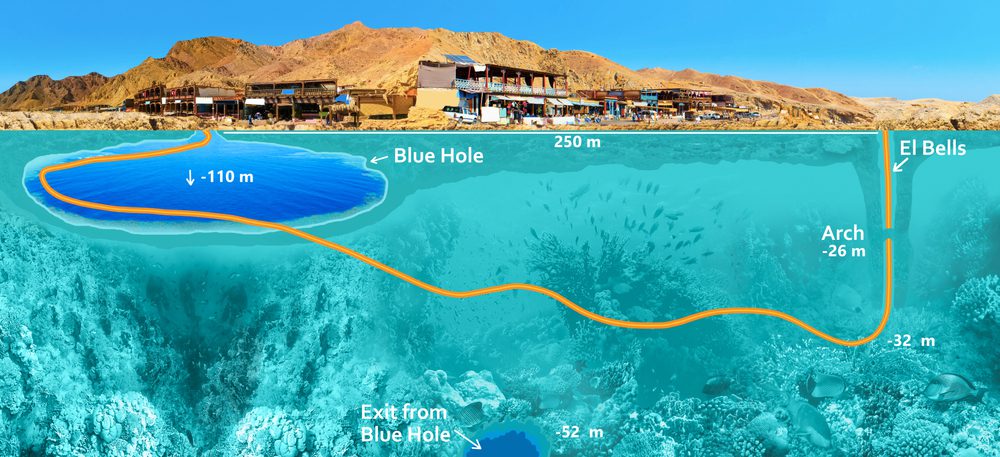Off the coast of Dahab, Egypt sits a cavernous hole stretching over 100 meters (328) feet into the depths of the Red Sea. Surrounded by coral and reef fish and containing a spectacular cathedral-esque arch, the natural beauty of the Red Sea Blue Hole continues to lure countless divers to their deaths, awarding it the name “Diver’s Cemetery”.
The deaths of at least 40 divers have been recorded in the area around the hole, but the death toll is actually estimated to be close to 200. Memorial plaques surrounding the entrance pay tribute to the many divers who have attempted to traverse the submerged cave system.
While it’s still unclear what makes the Red Sea Blue Hole the deadliest diving location on Earth, the geological structure of the hole is thought to be the cause.
The shallow 6-meter (20-foot) entrance, called “the saddle”, is close to the Dahab shore, and plunges straight down for 120 meters (328 feet). A tunnel known as “the Arch” is 55 meters (181 feet) down the sea wall, leading off from the hole. With a 65-meter (213-foot) floor-to-ceiling height, and stretching for 26 meters (85 feet), the tunnel is described as looking like an underwater cathedral.
Despite its ominous reputation (or perhaps because of it), the Blue Hole is an incredibly popular diving location, with explorers plunging its depths almost daily.
While recreational divers and tours of the area steer visitors away from the Blue Hole arch, some thrill-seekers still insist on traversing the tunnel that has led to so many deaths.
Tarek Omar, a technical driver from Dahab, began exploring the hole in 1992. Shortly after, in 1997, he began retrieving bodies. As the number of bodies pulled from the depths by Omar grew, he became known as the “bone collector”.
Of the local divers and instructors working in the area, some speculate the sheer number of deaths is down to the lack of knowledge and experience of some people looking to venture into the arch.
However, the complexity of this geological feature poses its own challenges.

What the Blue Hole actually looks like. Image credit: Solarisys/Shutterstockc.com
The depth of the entrance to the arch is hard to spot, if divers miss the entrance and continue down the 120-meter (328 feet) depth they can succumb to nitrogen narcosis, known as “the martini effect”, causing physical and mental impairment similar to the effects of alcohol.
Underestimating the immense length of the tunnel, combined with the extra energy needed to swim against the current flowing in from the open ocean, has meant divers sometimes run out of oxygen while trying to make their way out through the arch.
The Red Sea Blue Hole poses a number of dangers, and has claimed the lives of vastly experienced and prepared divers as a result. As the number of visitors doesn’t appear to be decreasing, the Blue Hole looks set to remain the deadliest diving spot on Earth.
Source Link: "Diver's Cemetery": Why This Is The Deadliest Place In The World To Dive